The Houston Photograph: Difference between revisions
No edit summary |
|||
| Line 50: | Line 50: | ||
It must also be appreciated that the picture of the basketball players is from 1969, almost 20 years after the photograph of William Branham was taken. It is likely that the lighting for a church gathering would have been set up completely different from that of a basketball game and also likely that the light fixtures would have been completely different 20 years earlier. | It must also be appreciated that the picture of the basketball players is from 1969, almost 20 years after the photograph of William Branham was taken. It is likely that the lighting for a church gathering would have been set up completely different from that of a basketball game and also likely that the light fixtures would have been completely different 20 years earlier. | ||
=The Role of the FBI= | |||
[[File:George J Lacy.jpg|left|George and Lucile Lacy]] | |||
William Branham stated many times that the FBI was somehow involved in authenticating the Houston photograph: | |||
:''The next morning, they flew the picture away to Washington, DC for a copyright. Before it could be released, it had to go before the FBI examinations. <ref>50-0714 AT.THY.WORD MINNEAPOLIS.MN</ref> | |||
:''And George J. Lacy, the best there is in United States, on research was brought from California to Houston, Texas, for to take the negative under consideration. He kept it for days. He looked through the lights; he looked at the camera. He took everything, and 'fore he could sign, because he's a FBI agent today, the best they got.<ref>52-0713A EARLY.SPIRITUAL.EXPERIENCES</ref> | |||
:''And now, this great Pillar of Fire that's absolutely identified even by scientific cameras, that's here on the earth today. There's the picture of It hanging there. I believe it's still there, isn't that right? Is it there? Scientifically proven by the best we got. George J. Lacy, the head of the FBI for fingerprint and documents, said, "I called it psychology myself, Reverend Branham, but," said, "the light struck the lens. I put it under ultra-ray lights and had an examination here for four or five days. And the light struck the lens. And this lens won't take psychology." Now, that's identified.''<ref>64-0823E QUESTIONS.AND.ANSWERS.2_ JEFFERSONVILLE.IN</ref> | |||
George Lacy was the fifth president of the American Society of Questioned Document Examiners. He owned and operated an indepedent forensics lab in Houston, Texas. There are a number of things that William Branham was not honest about relating to Mr. Lacy's involvement with the picture: | |||
#Mr. Lacy was not an employee of the FBI. He was '''NEVER''' the head of the FBI for fingerprint and documents. | |||
#The FBI had no involvement with the examination of the Houston photograph. | |||
#Mr. Lacy lived and practiced in Houston and was not brought from California to Houston to examine the photograph. | |||
William Branham appears to have invented all of these various stories in an attempt to hype the Houston photograph. | |||
=The Hall of Religious Art in Washington, D.C.= | |||
William Branham stated that a copy of the Houston photograph was in Washington, D.C.: | |||
:'''''And one of them is in Washington, DC, in the religious Hall of Art, with a note under it, "The only supernatural being was ever photographed in the history of the world."''' And now, then, if you're ever through there, drop in, see it.<ref>63-0606 SHOW.US.THE.FATHER TUCSON.AZ</ref> | |||
The problem with William Branham's statement is that there is no '''Hall of Religious Art''' in Washington, D.C. There is a copy of the picture that someone sent to the Library of Congress for their records. But the photo does not hang on the wall and there is no caption underneath it. Rather, it sits in a manila folder in a filing cabinet. | |||
=Report by George J. Lacy= | =Report by George J. Lacy= | ||
Revision as of 19:37, 29 July 2013
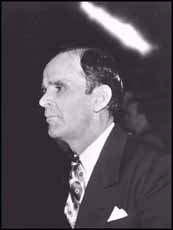 In Houston, Texas, on January 24, 1950, a strange photograph was taken by the Douglas Studios of a halo-like light above the head of Rev. William Branham. Gordon Lindsay took the negative to George J. Lacy, Examiner of Questioned Documents (who had acted as an external specialist for the FBI). George J. Lacy was asked to determine whether or not the light could have been the result of improper exposure, developing or retouching. This investigation concluded that the unusual brightness was caused by light striking the negative.
Facts surrounding the pictureIt was during the Houston campaign in 1950, that Rev. W. E. Best (representing the Houston Baptist Pastor's Conference) accused William Branham of racketeering and leading people astray. A public challenge was issued, and F.F. Bosworth accepted a challenge on the subject of "Divine Healing Through the Atonement." While Bro. Branham cautioned Brother Bosworth against being argumentative, the newspapers reported that the two ministers talked at once, and a fist-fight broke out in the audience. The meeting was given front-page publicity in the Houston newspapers. As the debate got under way, it was quite apparent that the sympathy of the vast audience was almost entirely on the side of the visiting evangelists. Large numbers of members from the same denomination as Rev. Best stood to their feet as witnesses that they believed in Divine healing and had in fact been healed. Rev. Best secured the services of Mr. James Ayers and Mr. Ted Kipperman, professional photographers from Douglas Studios in Houston, to document the evening. They were there in addition to the newpaper photographers. After taking several photos of Rev. Best, the photographer snapped a picture of William Branham, who spoke briefly just before the service closed. What William Branham said about the eveningWilliam Branham said that God would not allow a picture to be developed of Rev. Best pointing his finger at F.F. Bostorth 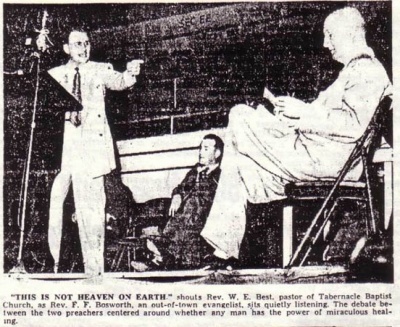 Click here to read a copy of the January 24th, 1950 issue of The Houston Press.
William Branham also said that it was George J. Lacy who first called it a supernatural light
Scepticism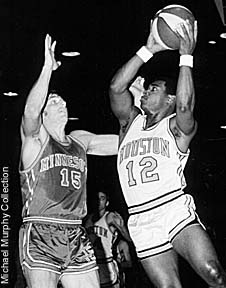 George J. Lacy's report did not comment on whether the source of the light was natural (i.e. electric indoor lighting) or supernatural. While newspaper articles about the Coliseum around that time show that there were flood lights in the building (including photographs of a concert by the Beatles), George J. Lacy's report does not indicate anything about the source of the light. Some observers note that if the pillar of fire was directly over William Branham's shoulder, it would have cast light on top of his head and the pulpit. Instead, the top of his head is not lit and the light appears to be from a source beyond William Branham. The most likely explanation for this is that the light is actually one of the indoor floodlight banks that was used in the Sam Houston Coliseum. These observers state that if the light was not from indoor lighting, it may have been the result of the flash from the camera reflecting off a metal pole or beam in the background. A Better Explanation?The picture immediately above on the right was taken in the Sam Houston Coliseum in 1969. At right is Willie Somerset (#12) of ABA's Houston Mavericks basketball team. Note the "pillar of fire" type light by the player's hand. If we zoom into the light by the players hand (see photo on left), we see something that is not that dissimilar to that of the picture of the "pillar of fire" that was photographed over William Branham's head. And this also lines up with the argument that the light passed through the lens of the camera and showed up on the negative. Because of the principle of "depth of field", a picture taken with a telephoto lens would tend to cause anything in the background to be out of focus. And given the poor dynamic range of film in the 1950's, a bright light source such as a rack of flood lights, would look "blown out" or overexposed in the photograph, just as the "pillar of fire" appears to be completely white. The Light Struck the Lens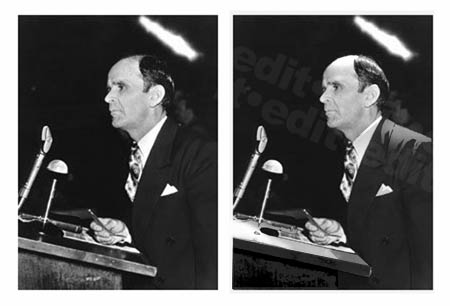 If, as George J. Lacy confirmed in his report on the photograph that light struck the negative, then it is hard to understand how no one else in the auditorium saw the light above William Branham's head. But if the light was, in fact, a bank of floodlights then light did pass through the lens and did strike the negative. Was the actual reason that no one noticed the "pillar of fire" was that they all saw it for what it really was - one of the flood lights in the Sam Houston Coliseum. If the "pillar of fire" was an actual light source above William Branham's head that showed up on the negative, why doesn't the photo look more like the edited version the right? It must also be appreciated that the picture of the basketball players is from 1969, almost 20 years after the photograph of William Branham was taken. It is likely that the lighting for a church gathering would have been set up completely different from that of a basketball game and also likely that the light fixtures would have been completely different 20 years earlier. The Role of the FBI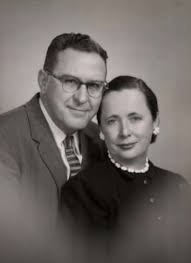 William Branham stated many times that the FBI was somehow involved in authenticating the Houston photograph:
George Lacy was the fifth president of the American Society of Questioned Document Examiners. He owned and operated an indepedent forensics lab in Houston, Texas. There are a number of things that William Branham was not honest about relating to Mr. Lacy's involvement with the picture:
William Branham appears to have invented all of these various stories in an attempt to hype the Houston photograph. The Hall of Religious Art in Washington, D.C.William Branham stated that a copy of the Houston photograph was in Washington, D.C.:
The problem with William Branham's statement is that there is no Hall of Religious Art in Washington, D.C. There is a copy of the picture that someone sent to the Library of Congress for their records. But the photo does not hang on the wall and there is no caption underneath it. Rather, it sits in a manila folder in a filing cabinet. Report by George J. LacyAfter conferring with Rev. Branham, Gordon Lindsay arranged for the negative to be turned over to George Lacy, a forensic examiner of documents. Mr. Lacy examined the negative. After his examination, Mr. Lacy gave a certified statement indicating that it was his opinion that the negative was genuine, and had not been "doctored" or retouched or the result of a double exposure. Today, the picture sits in a filing cabinet in the U.S Library of Congress in Washington, D.C. [1] 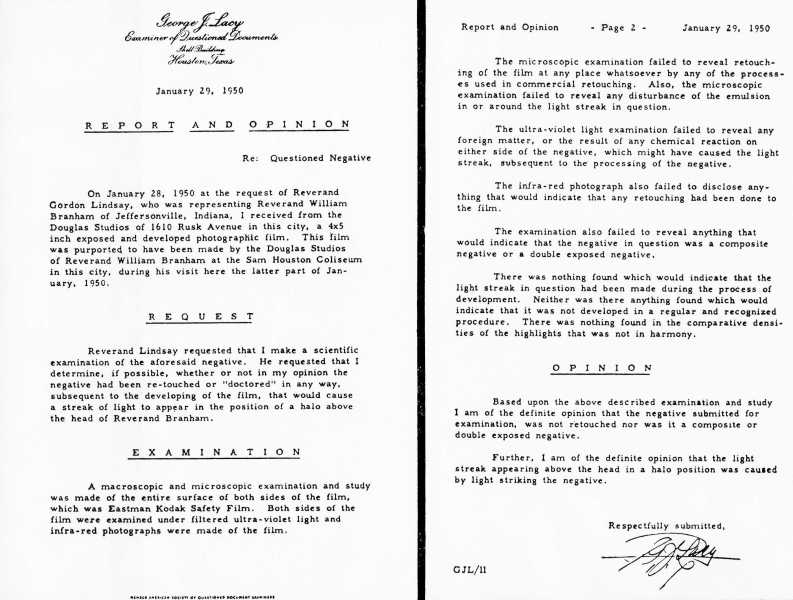 |